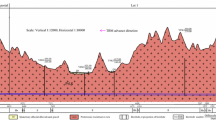Abstract
Disc cutters are the most commonly used cutting tools in the hard rock tunneling by tunnel boring machines (TBMs). During operation of a TBM in any project, disc cutters wear out and should be replaced to maintain high machine performance. This is especially true in very strong and abrasive rocks. In the process of planning and estimation of completion time and cost for a given tunneling project, the lifetime of the disc cutter is often predicted using the empirical models due to their simplicity and availability. But understanding the background of the models and the relative difference between both predicted and actual lifetimes is critical for improving the accuracy of estimated cutter life. In this study, the basis and input parameters of the most frequently used empirical models for prediction of disc wear life are examined. The result of estimating cutter life by using these models is compared in similar working conditions, including TBM specifications, operating conditions, and rock abrasivity. The results show that in slightly abrasive rocks, the empirical models should be carefully chosen, because the estimated disc life may spread over a wide range. Furthermore, some models are very conservative, while others offer more compatible estimates with the rock abrasivity. Also, in the Kerman water conveyance tunnel, the predicted and actual cutter lives show good correlation with the ratio of the rock mass and intact rock strengths, in addition to laboratory measures of rock abrasivity.






Similar content being viewed by others
References
Aghanabati A (2004) Geology of Iran. Ministry of Industry and Mines, Geological Survey of Iran, 582 p
Bieniawski ZT, Celada B, Galera JM, Tardáguila I (2009) Prediction of cutter wear using RME. In: Proceedings of ITA Congress, Budapest
Bilgin N (2016) An appraisal of TBM performances in Turkey in difficult ground conditions and some recommendations. Tunn Undergr Space Technol 57:265–276
Bruland A (1998) Hard rock tunnel boring. PhD Dissertation, Norwegian university of Science and Technology (NTNU)
Ewendt G (1992) Erfassung der Gesteinsabrasivität und Prognose des Werkzeugverschleißes beim maschinellen Tunnelvortrieb mit Diskenmeißeln. Kurzberichte aus der Bauforschung 33 (9)
Farrokh E, Kim DY (2018) A discussion on hard rock TBM cutter wear and cutterhead intervention interval length evaluation. Tunn Undergr Space Technol 81:336–357
Farrokh E, Rostami J, Laughton C (2012) Study of various models for estimation of penetration rate of hard rock TBMs. Tunn Undergr Space Technol 30:110–123
Farrokh E, Rostami J, Askilsrud OG (2013) A discussion on TBM cutter change time and cutter life. SME Annual Meeting
Frenzel C (2005) Mechanical tunneling in hard rock. Performance and wear predictions. Lecture at the TU Munich
Frenzel C (2011) Disc cutter wear phenomenology and their implications on disc cutter consumption for TBM. 45th US Rock Mechanics/Geomechanics Symposium. American Rock Mechanics Association
Frenzel C, Käsling H, Thuro K (2008) Factors influencing disc cutter wear. Geomech Tunn 1:55–60
Gehring KH (1995) Performance and wear prediction in mechanized tunneling. Rock engineering 13:6
Hassanpour J, Rostami J, Tarigh Azali S, Zhao J (2014) Introduction of an empirical TBM cutter wear prediction model for pyroclastic and mafic igneous rocks; a case history of Karaj water conveyance tunnel, Iran. Tunn Undergr Space Technol 43:222–231
Hassanpour J, Rostami J, Zhao J, Azali ST (2015) TBM performance and disc cutter wear prediction based on ten years experience of TBM tunnelling in Iran. Geomech Tunnell 8(3):239–247
Kizaoui M, a Wax E (2005) Einflussgrößen des Diskenmeißelverschleißes bei TBM-Vortrieben am Beispiel des Gotthard-Basistunnels. Acta Montan Slovaca 10(3):290–295
Koopialipoor M, Nikouei SS, Marto A, Fahimifar A, Armaghani DJ, Mohamad ET (2019) Predicting tunnel boring machine performance through a new model based on the group method of data handling. Bull Eng Geol Environ 78(5):3799–3813
Leitner W (2004) Baubetriebliche Modellierung der Prozesse maschineller Tunnelvortriebe im Festgestein. Institut für Baubetrieb, Bauwirtschaft und Baumanagement, Universität Innsbruck
Maidl B, Schmid L, Ritz W, Herrenknecht M (2008) Hardrock tunnel boring machines. John Wiley & Sons.
Majeed Y, Abu Bakar MZ, Butt IA (2019) Abrasivity evaluation for wear prediction of button drill bits using geotechnical rock properties. Bull Eng Geol Environ:1–21
Naghadehi MZ, Ramezanzadeh A (2017) Models for estimation of TBM performance in granitic and mica gneiss hard rocks in a hydropower tunnel. Bull Eng Geol Environ 76(4):1627–1641
Nelson P, Al-Jalil YA, Laughton C (1994) Tunnel boring machine project data bases and construction simulation. Geotechnical Engineering Report. The University of Texas at Austin, Austin
Rostami J, Ozdemir L, Bruland A, Dahl F (2005) Review of issues related to Cerchar abrasivity testing and their implications on geotechnical investigations and cutter cost estimates. Proceedings of the RETC, 738–751
Wan ZC, Sha MY, Zhou YL (2002) Study on disc cutters for hard rock application of TB880E TBM in Qinling tunnel (2). Modern Tunn Technol 39(6):1–12
Wang L, Kang Y, Cai ZC, Zhang Q, Zhao Y, Zhao H, Su P (2012) The energy method to predict disc cutter wear extent for hard rock TBMs. Tunnel Undergr Space Technol 28:183–191
Wei NZ, Sha MY (1999) The analysis of TBM cutter wear characteristic in the construction of Qinling tunnel. J Shijiazhang Railway Inst 12(2):86–89
Yagiz S (2006) A model for the prediction of tunnel boring machine performance. In: Proceedings of 10th IAEG Congress 1-10
Zhang X, Xia Y, Zhang Y, Tan Q, Zhu Z, Lin L (2017) Experimental study on wear behaviors of TBM disc cutter ring under drying, water and seawater conditions. Wear 392:109–117
Acknowledgments
The authors would like to express their sincere thanks to the assistance of the project manager and personnel of the Kerman water conveyance tunnel project for sharing the actual data of this project.
Author information
Authors and Affiliations
Corresponding author
Rights and permissions
About this article
Cite this article
Karami, M., Zare, S. & Rostami, J. Study of common wear prediction models for hard rock TBM disc cutters and comparison with field observation in Kerman water conveyance tunnel. Bull Eng Geol Environ 80, 1467–1476 (2021). https://doi.org/10.1007/s10064-020-01987-5
Received:
Accepted:
Published:
Issue Date:
DOI: https://doi.org/10.1007/s10064-020-01987-5



